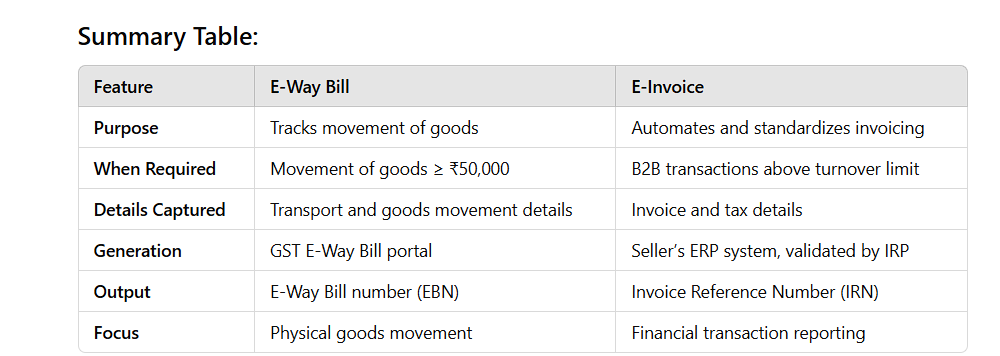The e-Way Bill and e-Invoice are both digital systems introduced in India under the Goods and Services Tax (GST) framework, but they serve distinct purposes. Here’s a detailed comparison:
1. Purpose:
- E-Way Bill:
- Facilitates the movement of goods.
- Used to track goods being transported from one place to another, ensuring compliance with GST regulations.
- E-Invoice:
- Standardizes and automates the invoicing process.
- Ensures real-time reporting of business-to-business (B2B) invoices to the GST system, reducing tax evasion and errors.
2. Applicability:
- E-Way Bill:
- Required for the transport of goods valued at ₹50,000 or more.
- Applies to both inter-state and intra-state movement of goods, with some exceptions (e.g., certain goods, distance limits).
- E-Invoice:
- Mandatory for B2B transactions for businesses exceeding a specified turnover limit (e.g., ₹5 crore as of the latest thresholds).
- Does not apply to certain entities like SEZ units or businesses dealing with exempt goods.
3. Key Information Captured:
- E-Way Bill:
- Transport-related details: Vehicle number, transporter ID, starting and ending points, and the nature of goods.
- E-Invoice:
- Invoice details: Supplier and recipient GSTIN, line-item details, tax breakdown, and IRN (Invoice Reference Number).
4. Compliance Mechanism:
- E-Way Bill:
- Generated on the GST E-Way Bill portal before goods are moved.
- Must be carried by the transporter during the movement of goods.
- E-Invoice:
- Generated by the seller’s accounting or ERP system.
- Reported to the GST e-invoice system (IRP – Invoice Registration Portal) for validation and generation of an IRN.
5. Integration with GST:
- E-Way Bill:
- Linked to GST returns indirectly by tracking the movement of goods.
- E-Invoice:
- Directly integrated with GST returns (GSTR-1). The invoice details are auto-populated in the GST returns and e-way bill system.
6. Format:
- E-Way Bill:
- Contains fields specific to the transport of goods and is simpler.
- E-Invoice:
- Has a standardized format as defined by GSTN (Goods and Services Tax Network), ensuring interoperability across systems.
7. Objective:
- E-Way Bill:
- Focused on tracking the physical movement of goods.
- E-Invoice:
- Ensures accurate and real-time reporting of financial transactions
